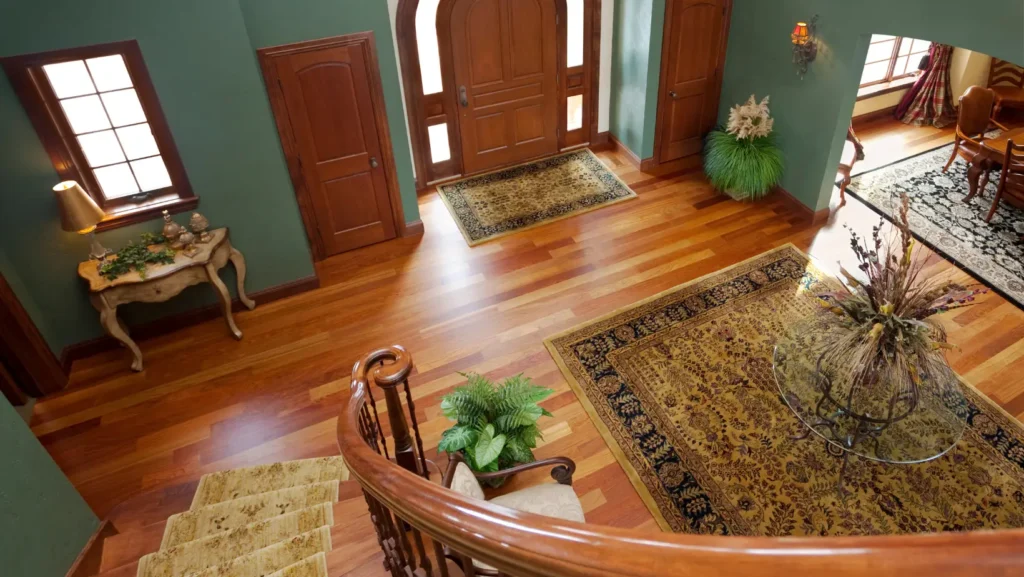If you have a gap between your floor and the wall, you may be wondering how to fill it. There are a few different ways you can do this, and the best option for you will depend on the size and shape of the gap.
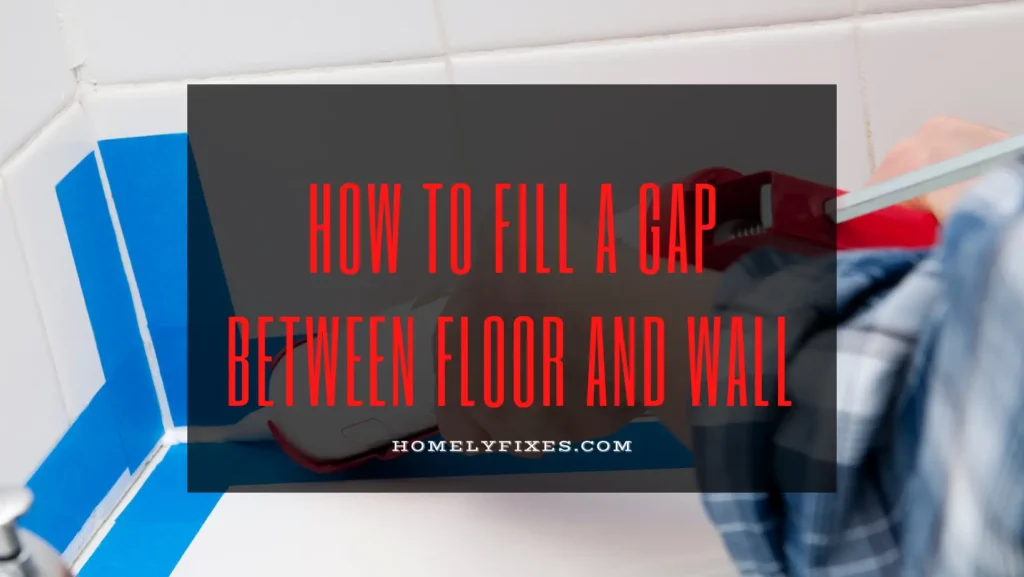
In this post, we’ll go over a few different ways to fill a gap between floor and wall so that you can choose the best option for your needs and the signs that indicate you should have a professional come to inspect and fix the problem.
Why Is There a Gap Between the Floor and the Wall in Your Home?
A gap between your home’s floor and wall can indicate different issues, including sagging subfloors, foundation settlement, expansion and contraction due to changing weather, and other structural issues.
Essentially, none of these causes are minor issues that should be ignored. However, the severity of the problem can be determined by the location of the house affected by the gap, the size of the gap, and other aspects of the home structure that is affected, such as wall cracks and ceiling.
For instance, a gap between your bathroom floor and the wall could be caused by excessive water penetration into the floor. In this case, simply sealing the floor with waterproof material will fill the gap and prevent moisture penetration.
Also, if only one room in your house is affected and the gap isn’t wider than 2 inches, filling the gap with caulk and a baker rod will suffice.
However, if the gap is excessively large and affects almost every part of your home, or if it extends to your wall and ceiling, or if there is a crack in your wall, it could be a sign of serious foundational or structural damage, such as a sinking foundation, damaged floor joists, or bowing walls. In this case, your home needs the immediate attention of a professional foundation repairer.
How Do You Fill a Gap Between the Floor and Wall?
Summary – The easiest way to seal a small gap between the floor and wall in your home is to use caulk. Latex caulk is recommended for use in most parts of the house because it is paintable. But to fill a floor and wall gap in your bathroom, use silicone caulk because it is strong and highly water resistant. However, if the gap is larger than ¼-inch, you must install a foam backer rod to cover the gap and to provide support for the caulk.
Tools and Materials Needed;
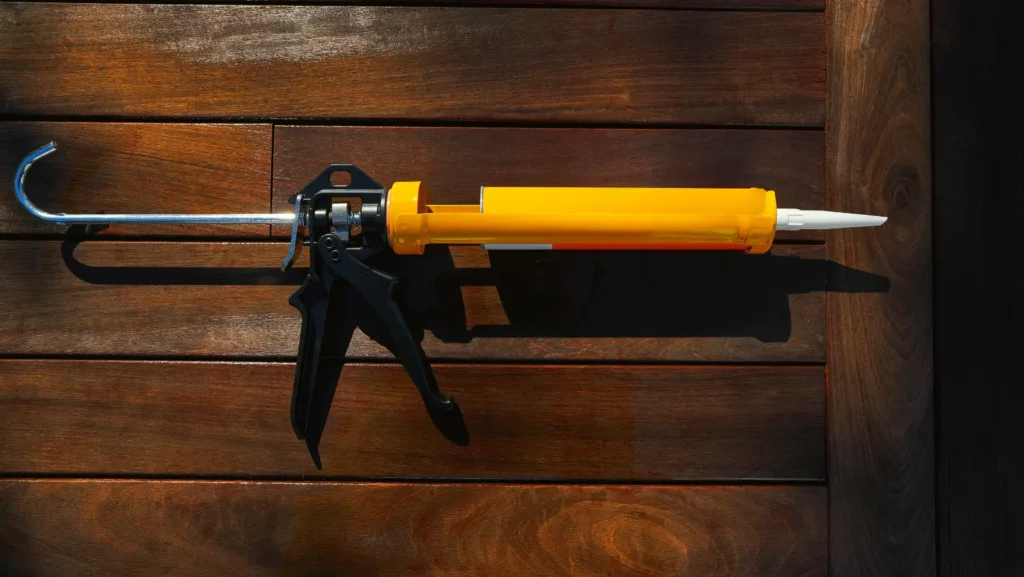
- Scraper or Putty Knife
- Vacuum Cleaner
- Rubbing Alcohol
- Rag
- Baker rod
- Latex or Silicone Caulk
- Caulking gun
- Caulking tool
- Scissors or utility knife
- Painter’s tape
Step 1: Determine the Cause of the Gap
Knowing that there are various causes of floor and wall gaps, the first step in fixing the problem is to inspect the area to determine the source of the gap. For example, if you notice a gap in your bedroom, you should look around the room for other signs of cracks and gaps on the floor or wall. You should also look around other rooms in the house for similar gaps between the wall and the floor.
Other ways to determine the cause of floor and wall gaps include:
- Check the crawl space beneath your floor for signs of moisture damage or rot on the floor joists. If you notice any damage down there, call a foundation repairer right away.
- Examine your plumbing lines for signs of water leaks. If you notice any water leaks around your plumbing pipes, contact a plumber before filling the floor gap.
- Hiring a professional building inspector to look for signs, causes, and potential solutions to the gap between your floor and the wall is also a good idea.
- After determining and correcting the foundational issue that is causing the gap between the floor and the wall, you can proceed to fill the gap.
Step 2: Measure the Gap
Now that you’re set to fill the gap, begin by measuring its width and depth. This will assist you in selecting the best filler material for the gap.
If the gap is ¼-inch or smaller, caulk alone can easily fill it. However, if the gap is wider than ¼-inch, you will need to use a pre-caulking material such as a backer rod to fill a significant portion of the space before applying caulk.
I recommend using a Digital Vernier Caliper to accurately measure the floor and wall gap.
- Insert the caliper into the gap to determine its depth and width.
- Use the caliper’s adjustment buttons to measure the gap accurately.
- Measure the gap at several points to see if some parts are wider than others and require pre-caulking.
Step 3: Prepare the Floor
A clean and well-prepared surface is essential for long-lasting caulking. As a result, before filling the gap between the floor and the wall, make sure to remove old dirt and keep the surface clean so that the caulk adheres firmly to it.
- Using a putty knife, scrape off dried paint or drywall compound from the wall and floor gap surface.
- If the old dried caulk is on the gap surface, scrape them off before applying the new caulk.
- Use a vacuum cleaner to remove any dust, dirt, or caulk pieces from the gap’s surface.
- Soak a clean sponge with rubbing alcohol and dip into the gap to remove loose dirt and stains and sanitize the area, so mold does not form when you seal it.
- Allow a few minutes for the area to dry.
- Then, tape off both the floor and wall (about 1/8-inch away from the gap), with painter’s tape. This ensures that caulk only gets into the gap and does not stain other parts of the floor and wall.
Step 4: Fill Gap with a Pre-Caulking Material
If the gap is larger than ¼-inch, use a pre-caulking material to fill it before applying the caulk. While there are a variety of materials available, I recommend using a backer rod.
A backer rod is a long foam cylinder that you can squeeze into gaps to provide something for the caulk to stick to. It is simple to use and is available in hardware and online stores.
- Buy a backer rod that is one size larger than the gap; this will tightly fit into the gap.
- Cut the baker rod to the length of the gap.
- Using your hand or a putty knife, press the backer rod into the gap as deep as you can.
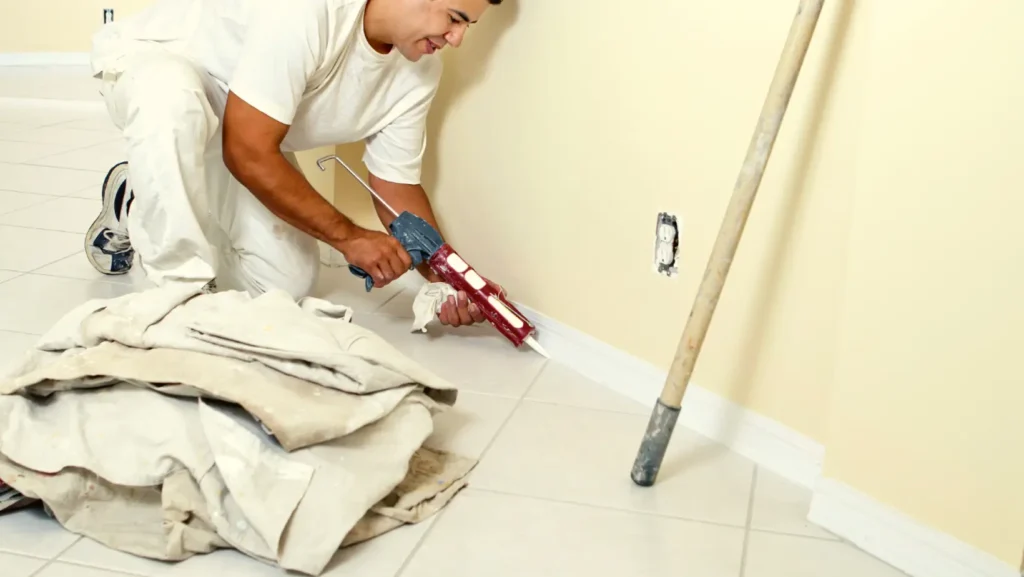
Step5: Apply Caulk into the Gap
Caulking the gap between your floor and wall is an easy, quick, and permanent solution. However, to achieve a tidy, long-lasting finish, it is essential to choose the right caulk for the job.
Use a latex caulk when filling a gap between a floor and a painted wall, such as in a bedroom or living room. It comes in a variety of colors and is paintable. But when sealing the gap between a tiled floor and wall, such as in a bathroom or shower, silicone caulk is recommended to create an airtight and waterproof seal.
Caulks are widely available in home improvement and hardware stores and online. The amount of caulk you need will be determined by the size of your room. for instance, a tube of caulk is sufficient to fill a gap in a bathroom floor and wall.
- Buy a caulk that matches the paint on your wall so the seal is not visible.
- Using scissors or a utility knife, cut the end of the tube at a 45-degree angle.
- Then, break the tube’s internal seal with a long pin or nail. And if your caulking gun comes with a pin, use it to break the caulk tube’s internal seal.
- Insert the tube into the caulking gun and secure it by pressing the metal rod back against the tube’s back.
- Hold the caulking gun against the gap at a 45-degree angle.
- Now, gently squeeze the caulking gun’s trigger to release the caulk from the nozzle.
- When the caulk comes out, fill the gap by sliding the tube along it.
- When sealing a large gap prefilled with a baker rod, ensure the rod is completely concealed under the caulk.
Step 6: Smoothen Sealed Surface and Allow Caulk to Dry
After applying caulk, you should smooth it out to make a nice and tight seal. You can either use a caulking tool or your finger to accomplish this task.
A caulking tool is a plastic piece with sharply defined edges that are used to push the caulk into the gap to spread it and create a smooth finish. It is easily available in hardware and home improvement stores and online.
Smoothening also makes it simpler to paint over the caulk.
- Run the caulking tool over the sealed surface to create a uniform and smooth caulk layer.
- As soon as the caulk has been smoothed, remove the tape before the caulk dries.
- Clean the floor and wall with a clean, damp rag to remove any excess caulk.
- Allow the caulk to dry for a full day before you can paint over it.
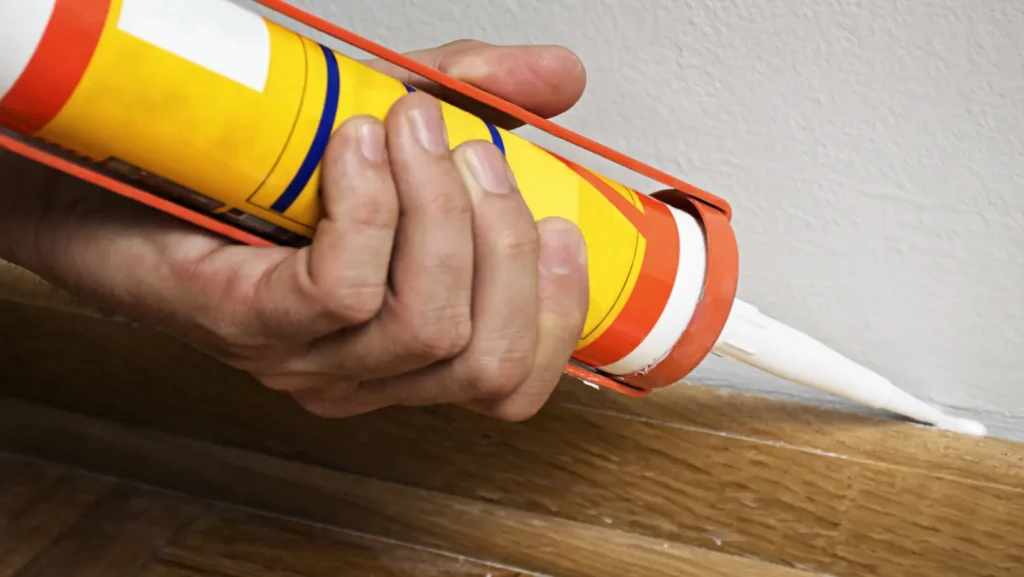
What Happens If You Don’t Fill a Gap Between Your Wall And Floor?
When there is a gap between the wall and the floor in your room, you should fill it immediately because such a gap is unsightly and can lead to other problems in your home that are more expensive to fix.
Here are some of the problems that a gap between your wall and floor could cause;
Pest Infestation: a gap between the floor and wall can easily become a route for insects and termites entering your home.
Sinking foundation: If you don’t seal the gap between your bathroom’s floor and wall, water can seep in there and eventually cause your subfloor to sag.
Increased energy bill: a gap between the floor and wall can leak out air from your room and allow unheated ones from outside. This causes your HVAC system to work harder, leading to an increase in your monthly electricity bill.
Mold growth: The gap could quickly become a breeding ground for mold since you cannot clean it.
Structural damage: A small gap between the floor and wall might not seem like a big deal now, but it could widen and cause more serious structural damage later on, such as an uneven floor, a collapsed wall, or even a collapsed ceiling.
Frequently Asked Questions
How Do I Seal a Two Inch Gap in the Floor along a Wall?
First, insert a pre-caulking filler, such as a backer rod, into the gap before you fill it with caulk. The next step is to select a latex painter’s caulk and fill the gap with it. Then, smoothen the caulk, and allow it to dry before painting the newly sealed surface.
When should I invite a professional to fix a floor and wall gap?
If the gap in your home’s floor and the wall is wider than 2 inches or appears everywhere in your home, it could be a sign of a serious structural problem. Don’t just patch the gap; rather, have a building expert or foundation repairer inspect and fix the underlying cause to prevent major structural damage.
